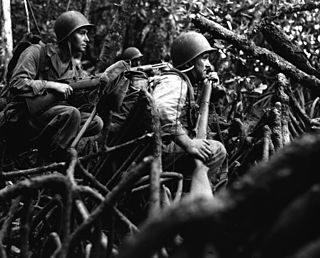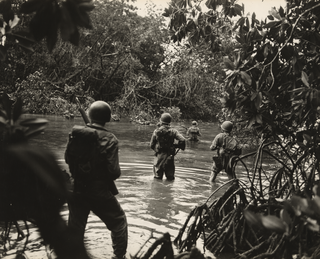
Munda is the largest settlement on the island of New Georgia in the Western Province of Solomon Islands, and consists of a number of villages. It is located at the southwestern tip of the western end of New Georgia, and the large Roviana Lagoon is just offshore.

The Asiatic-Pacific Theater, was the theater of operations of U.S. forces during World War II in the Pacific War during 1941–45. From mid-1942 until the end of the war in 1945, there were two U.S. operational commands in the Pacific. The Pacific Ocean Areas (POA), divided into the Central Pacific Area, the North Pacific Area and the South Pacific Area, were commanded by Admiral Chester W. Nimitz, Commander-in-Chief Pacific Ocean Areas. The South West Pacific Area (SWPA) was commanded by General Douglas MacArthur, Supreme Allied Commander South West Pacific Area. During 1945, the United States added the United States Strategic Air Forces in the Pacific, commanded by General Carl A. Spaatz.

The New Georgia Islands are part of the Western Province of Solomon Islands. They are located to the northwest of Guadalcanal. The larger islands are mountainous and covered in rain forest. The main islands are New Georgia, Vella Lavella, Kolombangara, Ghizo, Vangunu, Rendova and Tetepare. They are surrounded by coral reefs and includes the largest salt water lagoon in the world: Marovo lagoon.

Kolombangara is an island in the New Georgia Islands group of the nation state of Solomon Islands in the southwestern Pacific Ocean. The name is from a local language, a rough translation of its meaning is "Water Lord" with approximately 80 rivers and streams running down its flanks.

The Battle of Vella Gulf was a naval battle of the Pacific campaign of World War II fought on the night of 6–7 August 1943 in Vella Gulf between Vella Lavella Island and Kolombangara Island in the Solomon Islands of the Southwest Pacific.

The Battle off Horaniu was a minor naval battle of the Pacific campaign of World War II fought on the night of 17 August 1943 near the island of Vella Lavella in the Solomon Islands.

USS Chevalier (DD-451), a Fletcher-class destroyer, was the first ship of the United States Navy to be named for Lieutenant Commander Godfrey Chevalier.
The name Battle of Vella Lavella may refer to three related battles between the Allies and Japan in the Solomon Islands in 1943, during the Pacific campaign of World War II.

Western Province is the largest of the nine provinces of Solomon Islands. The area is renowned for its beautiful tropical islands, excellent diving and snorkelling, coral reefs and WWII wrecks, ecotourism lodges, and head-hunting shrines. The province contains many small lagoons and most of the country's tourist trade outside Honiara.

Vella Lavella is an island in the Western Province of the Solomon Islands. It lies to the west of New Georgia, but is considered one of the New Georgia Group. To its west are the Treasury Islands.

Kula Gulf is a waterway in the Western Province of the Solomon Islands. It lies between the islands of Kolombangara to the west, Arundel Island (Kohinggo) to the southwest, and New Georgia to the south and east. To the north, it opens into New Georgia Sound. To the southwest, it connects via Blackett Strait to Vella Gulf and the Solomon Sea.

The Battle of Vella Lavella was fought from 15 August – 6 October 1943 between Japan and the Allied forces from New Zealand and the United States. Vella Lavella, an island located in the Solomon Islands, had been occupied by Japanese forces early during the war in the Pacific. Following the fighting around Munda Point, the Allies recaptured the island in late 1943, following a decision to bypass a large concentration of Japanese troops on the island of Kolombangara.

Arundel Island is an island of the New Georgia Islands archipelago in the Western Province of Solomon Islands. Its indigenous names are Kohinggo and Ndokulu.

The South West Pacific theatre, during World War II, was a major theatre of the war between the Allies and the Axis. It included the Philippines, the Dutch East Indies, Borneo, Australia and its mandate Territory of New Guinea and the western part of the Solomon Islands. This area was defined by the Allied powers' South West Pacific Area (SWPA) command.
Liapari is an island in the Solomon Islands; it is located in the Western Province.

The Battle of Vella Lavella was a naval battle of the Pacific campaign of World War II fought on the night of 6 October 1943, near the island of Vella Lavella in the Solomon Islands. It marked the end of a three month fight to capture the central Solomon Islands, as part of the Solomon Islands Campaign.
The 30th Battalion was an infantry battalion of the New Zealand 3rd Division, raised for service during the Second World War. After being raised in late 1940, the battalion undertook garrison duties in Fiji and on New Caledonia during the early part of the war, before undertaking combat operations during the latter part of the Solomon Islands campaign, landing on Vella Lavella and the Green Islands in 1943–1944. The battalion was disbanded in mid-1944 to return manpower to the New Zealand economy and to provide reinforcements to the New Zealand 2nd Division, which was fighting in Italy.
USS LST-448 was a United States Navy LST-1-class tank landing ship used in the Asiatic-Pacific Theater during World War II.

USS LST-460 was a United States Navy LST-1-class tank landing ship used in the Asiatic-Pacific Theater during World War II. As with many of her class, the ship was never named. Instead, she was referred to by her hull designation.















